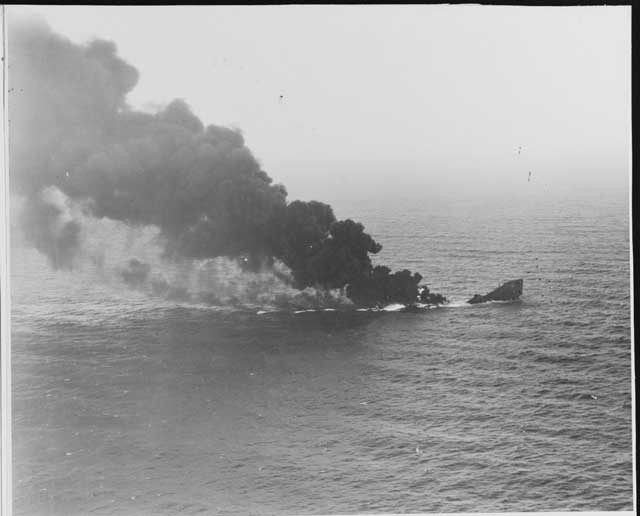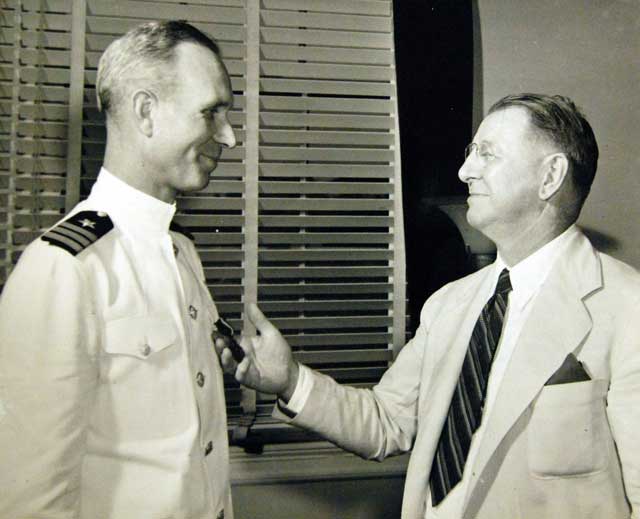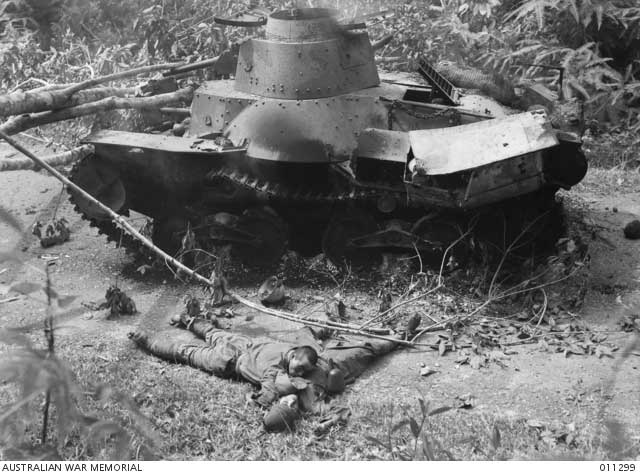Saturday 24 January 1942
 |
| British tanker Empire Gem sinks off Cape Hatteras after being torpedoed by U-66 on 24 January 1942 (Naval History and Heritage Command NH 54371). |
Battle of the Pacific: There is a short, sharp surface engagement between US Navy destroyers and Japanese surface ships off Balikpapan early in the morning on
24 January 1942. Sometimes called the Battle of Makassar Strait, it takes place during the Japanese landing at Balikpapan. The 59th US Navy Destroyer Division, under Rear Admiral William A. Glassford and Commander Paul H. Talbot, attacks following orders from Admiral Thomas Hart. There are 12 Japanese transport vessels and three old World War I-vintage Japanese destroyers serving as escorts just off Balikpapan. The US destroyers (USS Paul Jones, Parrott, Pope, and John D. Ford) use torpedoes to sink four transport ships (Kuretake Maru, Nana Maru, Sumanoura Maru, and Tatsukami Maru) and patrol boat P-37. There is gunfire between the armed transports and destroyer John D. Ford, with both ships suffering damage. The battle, the first true surface engagement of the war involving the United States Navy, is over by 04:00. The invasion, however, is unimpeded, with Major General Sakaguchi's 56th Mixed Infantry Group and the No. 2 Kure SNLF occupying Balikpapan and its critically important refineries without resistance.
This Battle of Makassar Strait is different than the one on 4 February 1942, which you may read about
here.
 |
| British tanker Empire Gem sinks off Cape Hatteras after being torpedoed by U-66 on 24 January 1942 (Naval History and Heritage Command NH 54213). |
In the Philippines, the Allied forces begin a broad retreat in the eastern II Corps sector. The Japanese maintain pressure on the Allies, particularly on the Philippine Division, but many of the Allied troops escape. In the western I Corps sector, the Japanese also gain ground. The 1st Division of the Philippine Army begins to crumble. A Japanese roadblock on the West Road which blocks US Army communications with its troops further north at the front continues to hold out despite increasingly frantic attempts to eliminate it. Small Japanese forces that recently landed well behind the front at Quinauan and Longoskawayan Points also continue to hold out.
Ad hoc US units including some US Marines do, however, make some progress there, regaining Pucot Hill and driving the Japanese back to Longoskawayan and Lapiay Points.
 |
| British tanker Empire Gem sinks off Cape Hatteras after being torpedoed by U-66 on 24 January 1942 (Naval History and Heritage Command NH 60611). |
In the Netherlands East Indies, the Japanese Eastern Invasion Force lands at Kendari on Celebes Island. Japanese destroyers and aircraft attack fleeing USN seaplane tender (destroyer), USS Childs (AVD-1, ex-DD-241), but it manages to escape to the south in stormy weather. The landings go well for the Japanese, who occupy Kendari and capture most of the Dutch defenders. As usual, some of the defenders escape into the interior and begin guerilla operations (which invariably are primarily focused on mere survival). The Japanese 21st Air Flotilla quickly beings operations from Kendari Airfield.
 |
| British tanker Empire Gem sinks off Cape Hatteras after being torpedoed by U-66 on 24 January 1942 (Naval History and Heritage Command NH 60610). |
On the Malay Peninsula, the situation continues to deteriorate for the Commonwealth troops. There is hard fighting at Batu Pahat and the Japanese approach Kluang. The Japanese 18th Division completes its landings at Singora. There is some renewed hope for the British when 942 men of the Australian 2/4th Machine Gun Battalion and 1907 other Australian reinforcements arrive in Singapore during the day. However, these men are short-timers without adequate training, and many have never even fired a rifle. General Arthur Percival issues his first plan for a complete withdrawal of all troops onto Singapore Island itself. However, the island has not been prepared for a siege and no fortifications have been built because the island's civilian workers who must do the work are demanding more money.
 |
| British tanker Empire Gem sinks off Cape Hatteras after being torpedoed by U-66 on 24 January 1942 (Naval History and Heritage Command NH 60612). |
In New Britain, Japanese forces begin mopping up operations south of Rabaul. Many Australian soldiers remain at large in the interior of the island, but they have no food or water or any means of resupply. The Japanese know this and post leaflets in English stating, "you can find neither food nor way of escape in this island and you will only die of hunger unless you surrender." The Japanese 3rd Battalion of the 144th Infantry Regiment under General Horii begins searching the southern part of the Gazelle Peninsula and captures the first of over 1000 Australian soldiers. The interior of the island is so rough and inhospitable, however, that Japanese efforts to clear New Britain require huge expenditures of effort and time.
 |
| US tanker SS Venore is one of two tankers sunk on 24 January 1942 by U-66 off the North Carolina coast. There are 21 deaths and 22 survivors. Venore was the other tanker sunk in the attack that also claimed Empire Gem. |
In the Gulf of Panama (on the Pacific side of the isthmus), submarine chaser USS Sturdy accidentally rams and sinks US submarine S-26. There are 43 deaths, the entire crew of USS S-26 excepting three men (the captain, executive officer, and a lookout) who are in the conning tower and survive.
 |
| Aboard a convoy ship at Methil on 24 January 1942. "General view showing the convoy gathering at the anchorage." © IWM (A 7219). |
Battle of the Atlantic: It is an active day in the Atlantic:
- U-106 (Oblt. Hermann Rasch), on its fifth patrol out of Lorient, torpedoes and sinks 5631-ton British freighter Emperor Wildebeeste (dispersed from Convoy ON-53) at 06:53 southeast of Halifax. There are nine dead and 34 survivors.
- U-66 (Kptlt. Richard Zapp), on its fourth patrol out of Lorient, is operating about 20 miles southeast of Cape Hatteras, North Carolina, when it torpedoes and sinks 8139-ton British tanker Empire Gem and 8017-ton US tanker Venore.
- U-333 (Kptlt. Peter Erich Cremer), on its first patrol out of Kiel and operating as part of Wolfpack Ziethen in the North Atlantic, torpedoes and sinks 4765-ton Norwegian freighter Ringstad, which also has been dispersed from Convoy ON-53.
Convoy QP-6 departs from Murmansk (QP convoys head east to west, PQ convoys head west to east). It includes six freighters and two Soviet Navy escorts. The Kriegsmarine has been beefing up its forces on the Arctic Convoy routes, but the days are short high above the Arctic Circle and German U-boats and planes have difficulty finding the Arctic Convoys.
 |
| Italian 13,098-ton Italian ocean liner MV Victoria, sunk on 24 January 1942 by a British air attack in the Gulf of Sirte. An Albacore of RAF No. 826 Squadron torpedoed the Victoria late on 23 January 1942. Italian destroyers Avere and Camicia Nera are nearby and pick up 1064 of the 1455 people on board. Victoria was part of Italian supply operation T-18, and the other ships in the convoy make it to Tripoli. |
Battle of the Mediterranean: German General Erwin Rommel's offensive is gathering speed, and already the British see which way the wind is blowing. The Royal Navy sends three destroyers (HMS Dulverton, Heythrop, and Southwold) from Alexandria to evacuate Benghazi. Rommel receives badly needed supplies in Tripoli when Italian supply operation T-18 makes port with 5322-ton Monviso, 5324-ton Monginevro, and 6339-ton Vettor Pisani. However, Rommel does not get all of his supplies because 6142-ton Ravello has to turn back to Messina with rudder problems. In addition, the real prize, 13,098-ton Italian liner Victoria, sinks en route after being torpedoed by an RAF Albacore of No. 826 Squadron. While 1064 of the 1455 people on board the Victoria do get rescued and make it to Tripoli, this is another troubling loss on a convoy route that the Italian Navy is proving unable to protect.
 |
| Aboard a convoy ship at Methil on 24 January 1942. "The 1st officer at work in the Chart Room." © IWM (A 7212). |
Eastern Front: A desperate German attempt to rescue an encircled 4000-man garrison at Sukhinichi barely succeeds on 24 January 1942. Generalmajor Werner von Gilsa has been able to hold out by receiving sporadic Luftwaffe supply drops. He also has been the beneficiary of somewhat clumsy Red Army attacks. A weak Second Panzer Army thrust east by 18th Panzer Division and the 208th Infantry Division exploits the weak Soviet cordon around the town to get near. A desperate battle involving reinforcements by both sides in -40 °F weather finally results in two battalions of the 18th Panzer Division reaching the town during the afternoon. It is a brilliant success, but the line back to the main German lines is extremely tenuous and Hitler still has not lifted his order to hold the town - so it is unclear if the rescuers will just get trapped there, too.
 |
| A Finnish Brewster Buffalo (No. BS-372) showing damage sustained during a mission on 24 January 1942. The plane was repaired and put back into service, ultimately being shot down and lost on 25 June 1942. The plane is found again in August 1998 in Big Kolejärvi Lake, about 50 kilometers from the town of Segezha. The Finns were the only major power able to make good use of the Brewster Buffalo after receiving a consignment of 44 of them from the United States during the Winter War. Reportedly, every Finnish Brewster averaged 11 victories. |
Since 22 January, a Red Army offensive by I and V Cavalry Corps has been chewing into the Army Group South line being held by General Hermann Hoth's 17th Army. The Soviet troops are making good progress west of Sloviansk. As with Soviet advances west of Moscow, the advance is impressive in terms of ground regained. It has retaken half the distance from Izyum to Dnepropetrovsk. However, there are no strategic objectives anywhere east of Dnepropetrovsk, which contains a vital crossing across the Dnieper River (one of less than a handful in the entire southern portion of the front).
 |
| ""Bagatelle", the office of the Flag Officer in Charge, Greenock." This photo was taken on 24 January 1942. © IWM (A 7732). |
Even further south, on the Crimea, the Soviets have not given up on their small landing force behind the German lines at Sudak. General Dimitri Kozlov, confused by the slow Axis reaction into thinking that the Germans have no troops available to eliminate the bridgehead, feeds more reinforcements into the bridgehead. In fact, the Germans have plenty of troops available but have been waiting to see if local Romanian troops can handle the situation. Local German commander General MaximilianFretter-Pico begins sending units of the German 30 Corps to the area, but they will not get into position for a forceful counterattack for a couple of days.
 |
| A view of the B-24 Liberator production line at the Consolidated Aircraft Production Plant No. 2, in the SPAWAR complex in San Diego, California, on 24 January 1942. The plant, incidentally, remains intact in the 21st Century. |
US Government: The Roberts Commission, formed in December 1941 to investigate the circumstances surrounding the Japanese attack on Pearl Harbor, releases its report to the public on 24 January 1942. Led by Supreme Court Justice Owen J. Roberts, the other members of the committee are all active or retired military officials: Admiral William H. Standley, Admiral Joseph M. Reeves, General Frank R. McCoy, and General Joseph T. McNarney. The Roberts Commission assigns the majority of the blame for the destruction of the US Fleet at Pearl Harbor on two men: General Walter C. Short and Admiral Husband E. Kimmel. The report singles them out for "dereliction of duty" for their lack of preparedness, a conclusion which many over the years consider typical scapegoating after an attack.
 |
| Change of command at Greenock. "Vice Admiral B. C. Watson, CB, DSO, FOIC, Greenock (center) with his staff after taking leave of them on being relieved." © IWM (A 7729). |
The Roberts Commission's Report also includes an offhand remark which addresses a question of rising importance to millions of people:
There were, prior to December 7, 1941, Japanese spies on the island of Oahu. Some were Japanese consular agents and other [sic] were persons having no open relations with the Japanese foreign service. These spies collected and, through various channels transmitted, information to the Japanese Empire respecting the military and naval establishments and dispositions on the island...
This statement has a devastating impact on public opinion. There were Japanese consular agents - or agents purporting to be consular officials - who spied on Pearl Harbor throughout much of 1941. The US intelligence services kept a close eye on them. However, it is unclear who the spies "having no open relations with the Japanese foreign service" were. This inflames public opinion and greatly accelerates the process of sending Japanese-Americans to internment camps. General John L. DeWitt, head of the Western Defense Command, meets with California governor Culbert Olson shortly after the report's release. Olson tells him:
Since the publication of the Roberts Report, they [the people of California] feel they are living in the midst of enemies. They don't trust the Japanese, none of them.
All of this is undoubtedly true, the only open question is whether the Roberts Commission was correct about there being private Japanese spies and, if so, who they were. That question is never satisfactorily answered. Heretofore, General DeWitt has taken a moderate opinion on the question of internment, but, following the release of the Roberts Commission Report, he redoubles his efforts to intern Japanese-Americans.
 |
| Commander Paul H. Talbot receives the US Navy Cross for "especially meritorious conduct, extreme courage and complete disregard for his own personal safety" as commander of Destroyer Squadron 59 on the night of 24 January 1942. "LC-Lot-4263-32: Battle of Balikpapan, January 24, 1942. The Honorable Frank Knox, Secretary of the Navy, presents the Navy Cross to Commander Paul H. Talbot, USN, July 11, 1942. Secretary of the Navy Frank Knox Collection. Photographed through Mylar sleeve. Courtesy of the Library of Congress. (2015/11/20)." |
1942January 1942January 1, 1942: Declaration By United NationsJanuary 2, 1941: Manila Falls to JapanJanuary 3, 1942: ABDA Command AnnouncedJanuary 4, 1942: MacArthur on His Own in the PhilippinesJanuary 5, 1942: Soviets Plan General OffensiveJanuary 6, 1942: US Army in EuropeJanuary 7, 1942: Soviet General Offensive OpensJanuary 8, 1942: Hitler Sacks HoepnerJanuary 9, 1942: Battle of DražgošeJanuary 10, 1942: Building the JeepJanuary 11, 1942: Japan Takes Kuala LumpurJanuary 12, 1941: Rommel Plans CounterattackJanuary 13, 1942: First Ejection Seat UseJanuary 14, 1942: Operation Drumbeat First SinkingJanuary 15, 1942: U-Boat Off NYCJanuary 16, 1942: Carole Lombard CrashJanuary 17, 1942: British Take Halfaya PassJanuary 18, 1942: Soviet Paratroopers in ActionJanuary 19, 1942: FDR Approves Atomic BombJanuary 20, 1942: The Wannsee ConferenceJanuary 21, 1942: Parit Sulong Bridge BattleJanuary 22, 1942: Parit Sulong MassacreJanuary 23, 1942: Japan Takes RabaulJanuary 24, 1942: Battle of Makassar StraitJanuary 25, 1942: Kholm SurroundedJanuary 26, 1942: GIs Land in EuropeJanuary 27, 1942: Battle of EndauJanuary 28, 1942: Rommel Takes BenghaziJanuary 29, 1942: First US Coast Guard Ship SunkJanuary 30, 1942: Singapore IsolatedJanuary 31, 1942: Army Group South Averts Disaster2020


























